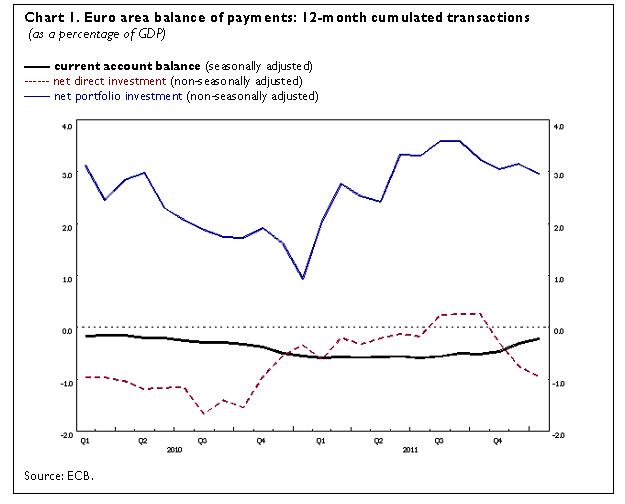Euro area balance of payments in January 2012
In January 2012 the seasonally adjusted current account of the euro area recorded a surplus of €4.5 billion. In the financial account, combined direct and portfolio investment recorded net outflows of €53 billion (non-seasonally adjusted).
Current account
The seasonally adjusted current account of the euro area recorded a surplus of €4.5 billion in January 2012 (see Table 1). This reflected surpluses for goods (€4.9 billion), services (€3.9 billion) and income (€3.0 billion), which were partially offset by a deficit for current transfers (€7.3 billion).
The 12-month cumulated seasonally adjusted current account recorded a deficit of €21.2 billion in January 2012 (around 0.2% of euro area GDP – see Table 1 and Chart 1), compared with a deficit of €50.6 billion a year earlier (around 0.6% of euro area GDP). The reduction of the current account deficit resulted from increases in the surpluses for income (from €1.2 billion to €13.7 billion), services (from €47.5 billion to €59.0 billion) and goods (from €5.4 billion to €8.7 billion), and from a decrease in the deficit for current transfers (from €104.7 billion to €102.6 billion).

Financial account
In the financial account (see Table 2), combined direct and portfolio investment recorded net outflows of €53 billion in January 2012, as a result of net outflows both for portfolio investment (€47 billion) and for direct investment (€6 billion).
The net outflows for direct investment resulted from net outflows in equity capital and reinvested earnings as well as from net outflows in other capital (mostly inter-company loans) (€3 billion in both cases).
The net outflows for portfolio investment were mainly accounted for by net outflows for debt instruments (€52 billion), which were partly offset by net inflows for equity (€5 billion). The net outflows for debt instruments resulted mainly from net sales of euro area bonds and notes by non-residents (€34 billion), and from net purchases of foreign bonds and notes by euro area residents (€20 billion).
The financial derivatives account recorded net outflows of €3 billion.
Other investment recorded net inflows of €70 billion, reflecting net inflows for MFIs excluding the Eurosystem (€101 billion) and general government (€8 billion), which were partly offset by net outflows for the Eurosystem (€38 billion) and other sectors (€2 billion).
The Eurosystem’s stock of reserve assets increased by €35 billion in January 2012 (from €667 billion to €702 billion), mainly on account of an increase in the market price of gold (with net transactions contributing €1 billion to the overall increase in reserve assets).
In the 12-month period to January 2012, combined direct and portfolio investment recorded cumulated net inflows of €189 billion, compared with net inflows of €55 billion in the preceding 12-month period. This increase was largely the result of higher net inflows for portfolio investment (increasing from €86 billion to €278 billion), which in turn reflected mainly a switch from net purchases (€164 billion) to net sales (€77 billion) of foreign securities by euro area residents.
Data revisions
This press release incorporates revisions to the data for December 2011. These revisions have not significantly changed the previously published data.
Additional information on the euro area balance of payments and international investment position
In this press release, the seasonally adjusted current account refers to working day and seasonally adjusted data. Data for the financial account are not working day or seasonally adjusted.
In line with the agreed allocation of responsibilities, the European Central Bank compiles and disseminates monthly and quarterly balance of payments statistics for the euro area, whereas the European Commission (Eurostat; see news releases for “Euro-indicators”) focuses on quarterly and annual aggregates for the European Union. These data comply with international standards, particularly those set out in the IMF’s Balance of Payments Manual (fifth edition). The aggregates for the euro area and the European Union are compiled consistently on the basis of transactions and positions vis-à-vis residents of countries outside the euro area and the European Union respectively.
A complete set of updated euro area balance of payments statistics (including a quarterly geographical breakdown for the main counterparts) and international investment position statistics is available in the “Statistics” section of the ECB’s website under the headings “Data services”/“Latest monetary, financial markets and balance of payments statistics”. These data, as well as historical euro area balance of payments time series, can be downloaded from the ECB’s Statistical Data Warehouse (SDW). Data up to January 2012 will also be published in the April 2012 issues of the ECB’s Monthly Bulletin and Statistics Pocket Book. Detailed methodological notes are available on the ECB’s website. The next press release on the euro area monthly balance of payments will be published on 18 April 2012, together with the quarterly international investment position.
Annexes
Table 1: Current account of the euro area
Table 2: Monthly balance of payments of the euro area
Evropská centrální banka
Generální ředitelství pro komunikaci
- Sonnemannstrasse 20
- 60314 Frankfurt am Main, Německo
- +49 69 1344 7455
- media@ecb.europa.eu
Reprodukce je povolena pouze s uvedením zdroje.
Kontakty pro média

